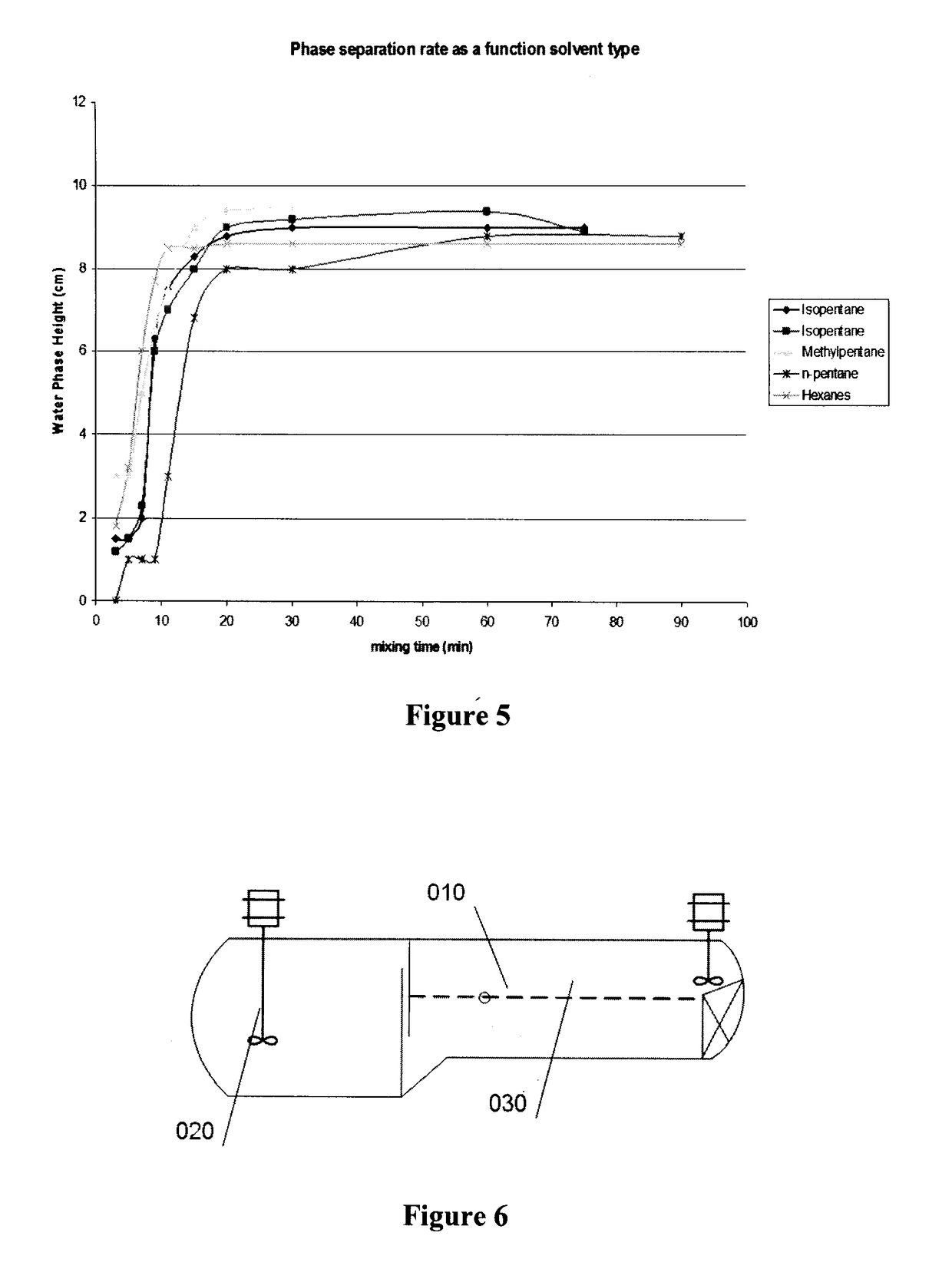Process and apparatus for production of halogenated butyl rubber with reduced emissions
a technology of halogenated butyl rubber and process, which is applied in the direction of chemical/physical/physical/physical-chemical process, chemical/physical/physical-chemical stationary reactor, chemical/physical/physical-chemical reactor details, etc. it can solve the problems of process and mechanical reliability problems, limitations of the process disclosed, and the existing system is not suitable for use with certain non-halogenated organic solvents having a lower boiling point than hexane, etc. problems, to achieve the effect o
- Summary
- Abstract
- Description
- Claims
- Application Information
AI Technical Summary
Benefits of technology
Problems solved by technology
Method used
Image
Examples
example 1
Laboratory Batch Experiments
[0058]Batch experiments were carried out using a closed glass reactor apparatus to simulate plant conditions. The main variables that were investigated for their influences on the cement make up process are: agitation time; temperature (23° C., 40° C. and 65° C.); butyl rubber grades (LANXESS chlorobutyl CB1240 and bromobutyl BB2030, BB2040 and BBX2 base rubbers) rubber particle size (large crumb size: 6.3-19.9 mm, small crumb size: 0.5-3.5 mm); calcium stearate level (1% and 3%); and solvent type (hexanes, isohexane, isopentane, n-hexane).
Materials Used in this Study
[0059]Butyl rubber crumb (chlorobutyl CB1240 and bromobutyl BB2030, BB2040 & BBX2 base rubber) was used as supplied by LANXESS Inc.[0060]LANXESS bromobutyl BB2030 is a brominated isobutylene-isoprene copolymer with a bromine content of 1.8±0.2 wt-% and a Mooney viscosity (ML 1+8 @ 125° C.) of 32±4.[0061]LANXESS chlorobutyl CB1240 is chlorinated isobutylene-isoprene copolymer with a chlorine c...
example 2
Batch Trials
General Description of Procedure
[0113]A 50-L vessel equipped with 4 flat baffles and a 3-stage Viscoprop agitator was used in LANXESS Rubber plant to carry out the batch trials in order to determine the detail design dimensions of the production scale vessel.
[0114]Crumbs were collected from the rubber plant and separated from the bulk water. The amount of crumbs for one trial was weighed in the laboratory. Water, which was also taken directly from the rubber slurry from the plant, was metered into the mixing vessel manually, and then the pre-weighed amount of rubber crumbs was inserted into the mixing vessel. The agitator was started and the vessel closed. The mixing vessel was brought to the desired temperature by means of a heating jacket. After the polymerization reaction was quenched, the solvent was metered into the closed vessel in the desired amount. Through a sight glass at the side of the vessel, the flow and settling behaviour were observed. Samples were taken ...
example 3
Continuous Pilot Scale Tests
[0138]A pilot mixer / settler scaled down from the full scale design was constructed to verify the mixing and settling efficiency under continuous flow conditions. The pilot mixer / settler is composed of two mixing chamber (each has a diameter of 1200 mm) and a settling chamber with a diameter of 508 mm. The total volume of the mixing and settling section is 2920 L. The mixing chambers are equipped with agitators. A small agitator is installed at the end of the settling chamber to break any rubber mat build up. The rubber slurry and plant hexane were pumped from the main production facility to the pilot unit. The cement and water separated out of the mixer settler were pumped back to the production unit. The tests were conducted under the following conditions,[0139]Product Grade=BB2030 base polymer[0140]Slurry concentration to pilot=6 wt %[0141]Cement concentration target=20 wt %[0142]Mixing agitator speeds (A8701 and A8702) were set at 83%, i.e. 141 rpm[014...
PUM
| Property | Measurement | Unit |
|---|---|---|
| mol % | aaaaa | aaaaa |
| temperature | aaaaa | aaaaa |
| temperature | aaaaa | aaaaa |
Abstract
Description
Claims
Application Information
 Login to View More
Login to View More - R&D
- Intellectual Property
- Life Sciences
- Materials
- Tech Scout
- Unparalleled Data Quality
- Higher Quality Content
- 60% Fewer Hallucinations
Browse by: Latest US Patents, China's latest patents, Technical Efficacy Thesaurus, Application Domain, Technology Topic, Popular Technical Reports.
© 2025 PatSnap. All rights reserved.Legal|Privacy policy|Modern Slavery Act Transparency Statement|Sitemap|About US| Contact US: help@patsnap.com



